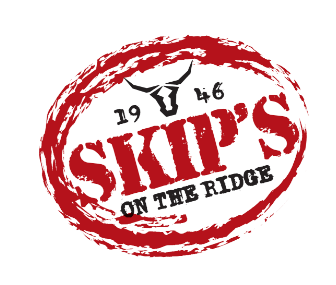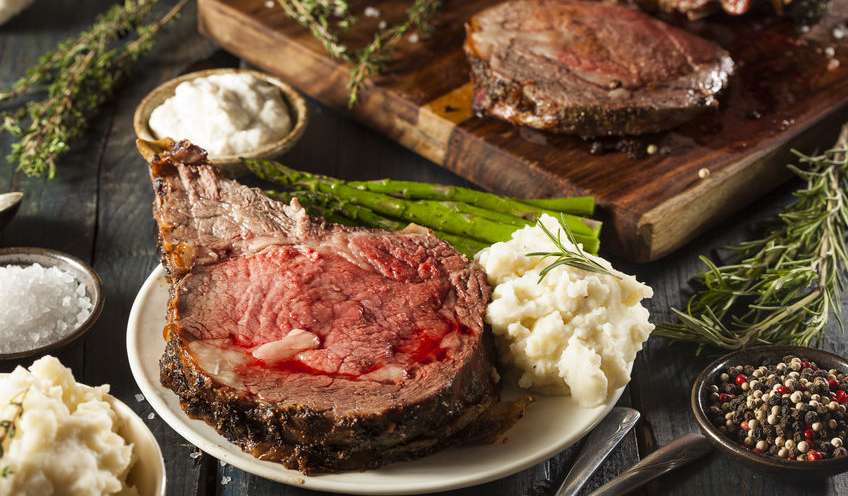If you’ve never prepared a prime rib roast before, you might be intimidated to cook your first one this holiday season. But you shouldn’t be! Perhaps you have cooked prime rib before but you’re ready for some new ideas for the rub. Either way, keep reading and you’ll find this timeless Christmas tradition will leave your guests coming back again and again over the years.
1. Choose Your Rib Wisely
A well-chosen roast means you won’t have to stress about the extras as much. The phrase “prime rib roast” can be misleading, since it doesn’t refer to the USDA’s grading method for prime cuts of meat. Prime rib actually indicates that the highest quality of meat from the rib was selected. At Skip’s, we can help you find meat that is most desirable.
Estimate how many people you’re expecting.
On average, each person will eat about three-fourths of a pound (or 12 oz.) of meat during an intimate, sit-down meal. If you’re planning a buffet-style get-together, average a half pound of boneless meat (8 oz.) per person. If you’d like bone-in prime rib, we recommend you purchase 1 bone for every 2 adults for the holidays. The bones add weight and isn’t necessarily an edible part of the roast.
Select your bone-in prime rib.
We highly recommend bone-in rib roast as it renders a more succulent, juicy flavor. When you place the roast fat side up in the pan, the rib bones also serve as a roasting rack, so the meat doesn’t touch the bottom of the pan while it’s cooking.
Upon request, our butchers will also trim and tie the meat for you so you won’t have to worry about how to do it yourself. We can cut away the bones, trim the fat, and then tie the bones back together. We can also leave about one inch of fat on the bones to add to the flavor of the roast.
2. Prepare the Rub
You can season the roast a day in advance, but no later than 2 hours before cooking time. The seasoning needs time to flavor the meat while it’s raw. When you’re ready to season, you can pick from countless options for rubs.
First, cover the entire roast with olive oil – this will help give the exterior a flavorful, crusty texture. You can then keep it simple by mixing ¼ cup kosher salt with ¼ cup pepper and rubbing it all over the roast. If you want something a bit more fancy, consider these options:
Classic:
Mix together: ⅓ cup kosher salt; 3 Tbsp. dry mustard; 4 tsp. black pepper; 1 ½ tsp. garlic powder; 1 Tbsp. onion powder; 2 tsp. dried thyme; 2 tsp. dried oregano; 2 tsp. ground coriander; and 2 tsp. celery seeds. (Note: this will make more than you need, so use about 1/4 cup of the mixture and save the rest for the next big holiday!)
Sweet:
Mix: 2 Tbsp. black pepper; 2 Tbsp. kosher salt; 2 Tbsp. light brown sugar, packed; 1 Tbsp. dried oregano; and 1 tsp. smoked/sweet paprika.
Savory:
Combine: 3 cloves of garlic, crushed; ¼ cup Dijon mustard; ¾ cup chopped fresh parsley; 1 ½ Tbsp. fresh (or 1 ½ tsp dried) thyme leaves; and 1 ½ Tbsp. fresh (or 1 ½ tsp. dried) rosemary leaves.
Once you decide on your rub, simply sprinkle until the whole roast is covered. You can also slice 1 inch by ½ inch into the fat side of the roast to help the flavor of the rub penetrate deep into the meat.
3. Cook the Rib
Before you cook the rib, make sure the roast is at room temperature, so remember to remove the roast from the fridge at least two hours before you plan on putting it in the oven. Preheat the oven to 450°F.
Place the roast fat side up, bone side down, in a large roasting pan. Cook for 15 minutes, then reduce the oven temperature to 325°F. This allows the heat to sear the roast, trapping the juicy flavors inside while the rest of the meat cooks. On average, each pound of rib needs 15 minutes to cook (i.e., a 4 lb. roast needs to cook for 1 hr. after the temperature has been reduced).
For absolute accuracy, purchase a meat thermometer. Some versions remain in the meat as it cooks, while others are removable, but either will help you know when the roast is fully cooked. The thermometer should read 110°F before you pull it out of the oven.
After you pull it out, cover it loosely with aluminum foil and let it rest for 20 minutes. The roast will continue to cook, raising the internal temperature to about 130°F. This allows the flavor from the juice to settle over the entire roast.
At this point, simply remove the foil, cut the ties, and serve this unforgettable, medium rare prime rib roast to your hungry guests! Some perfect sides are creamed spinach, green bean casserole, mashed potatoes, and dinner rolls.
Want to place an order for your prime rib roast? Order online or call 585.865.3896 for any occasion!

